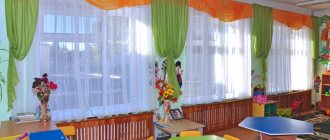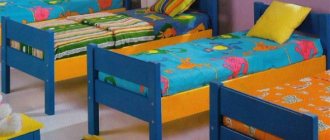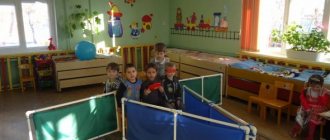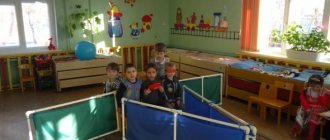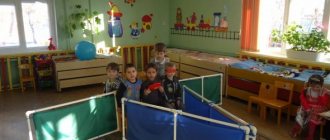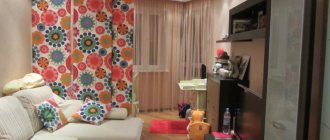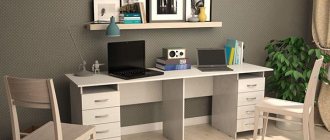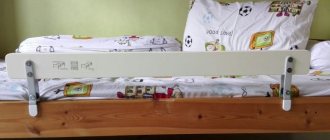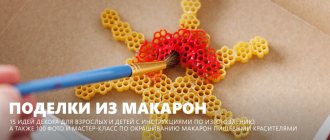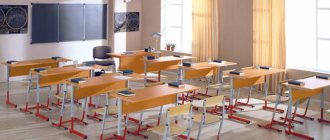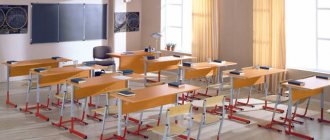When the time comes for a child to attend kindergarten, every parent wants this period of life to leave only positive emotions for the preschooler. The first thing a child will see when meeting his group is the locker room. The impression and the child’s desire to come back here again depend on its design. Since a significant part of the locker room area is occupied by lockers, they should be designed in such a way as to evoke coziness and comfort. The main point in the design will be the stickers on the kindergarten lockers, because their implementation should attract and interest the child.
Purpose
To provide the child in kindergarten with the maximum level of comfort, the group has a special room for changing into spare clothes and shoes.
The sanitary standard applies to kindergartens and age groups in them. In such a room, the number of cabinets is installed according to the number of children attending a particular group. What is the purpose of such furniture? It is necessary so that the child can, after changing clothes, neatly fold his clothes and shoes. Most kids who have just entered kindergarten cannot read. So that they can accurately remember their closets with clothes and shoes, children hang special stickers on the doors of such furniture or glue them to the cabinets. They are very diverse in design, color, size, thematic component, material and method of fastening to the surface of the cabinet door
All varieties of such decor perform an important function - to attract the child’s attention and allow him to highlight his own against the background of other cabinets.
What do you need to know about SanPiN in preschool institutions?
Sanitary and hygienic rules and regulations for preschool institutions are approved by SanPiN 2.4.1.3049-13.
The act, approved by the Decree of the Chief Sanitary Doctor of the Russian Federation dated May 15, 2013 No. 26, includes rules governing the organization of the organization and the rules for the use of accessories for children accepted into groups.
The act establishes requirements for:
- location of the preschool educational institution;
- equipment, including its location;
- maintenance of territories related to a children's educational institution;
- maintenance, decoration of premises, the building itself;
- lighting of rooms, as well as auxiliary premises (natural and artificial);
- heating, water supply, ventilation, sewerage and other systems;
- the formation of groups that accept children with diseases that limit their health;
- admission of minors to organizations implementing preschool education programs;
- organization of the regime and educational process, including training;
- equipment, inventory, toys, dishes and equipment in the catering department;
- conditions of preparation, storage of food, menu preparation;
- transportation, food intake;
- hygienic, anti-epidemic measures;
- compliance with sanitary standards.
All of the above requirements must be strictly observed by employees of preschool institutions.
For refusal to comply with the rules, citizens and organizations face a hefty fine. Next we will talk about labeling furniture and utensils in preschool educational institutions.
Pictures for cabinets with soft toys – Everything for kindergarten
Types of play furniture for kindergarten, criteria for choosing
30 bright and colorful pictures for lockers in a kindergarten group.
All files are made in high quality with a resolution of more than 800 pixels in width. This aspect allows you to print pictures even entirely one at a time on one A4 sheet.
In the printer's print settings, you can select 2 or 4 images per sheet.
Especially for the convenience of printing, when there is no need for huge cards and cabinets are decorated with small pictures, we have prepared 4 A4 sheets with 9 cards glued together. After printing, you just need to cut them out with scissors:
Collection 1 Collection 2 Collection 3 Collection 4
All 30 pictures are published below in good quality:
How are chairs and tables marked in kindergarten according to SanPiN?
According to clause 6.6 of SanPiN, chairs and tables used by kindergarteners must comply with standards taking into account the physiological characteristics of children and be labeled in accordance with them.
The choice of furniture is carried out according to such parameters as the child’s height.
A standardized table is used for this:
| Group (height in centimeters) | Furniture group | Tabletop height (in centimeters) | Seat height (cm) | Marking furniture in kindergarten according to SanPiN |
| ≤85 | 00 | 34 | 18 | black |
| 85-100 | 0 | 40 | 22 | white |
| 100-115 | 1 | 46 | 26 | orange |
| 115-130 | 2 | 52 | 30 | violet |
| 130-145 | 3 | 58 | 34 | yellow |
| 145-160 | 4 | 64 | 38 | red |
Clause 6.7 of SanPiN establishes the requirements for the countertop. The latter has a matte surface of a light shade.
Color of furniture markings in kindergarten.
Furniture cladding must be resistant to detergents (disinfectants), moisture, and also have low thermal conductivity.
Sanpin for kindergartens. [274.00 KB]
How to choose depending on the child’s age
Options for pencil case cabinets in the kitchen, selection criteria
Cabinets for kindergartens are coated with varnish or an even layer of paint. Thanks to this solution, children will not quarrel over the colors of the furniture. Each compartment for things belongs to one child, so special stickers are used for identification, which are selected taking into account age characteristics:
- Nursery group. Kids who do not yet know numbers and cannot read can perfectly distinguish and remember animals and fairy-tale characters. Bright stickers will help the baby distinguish his own closet from others.
- Middle group. The simplest geometric figures are suitable: triangles, circles, squares, stars. A sign for parents is placed inside the locker room with signs for each child.
- Senior group. Numbers can be used to design lockers. You should first make sure that all children know the numbers and there will be no confusion.
Experts do not recommend choosing inscriptions and letters for marking. Not all kindergarten-aged children will be able to read what is written. If such a sticker is used, it must be supplemented with a small picture.
Dimensions and markings of tables and chairs for preschool children.
| Furniture group | Marking color | Height group, cm | Table height above the floor, cm | Seat height above floor, cm |
Making children's beds
two types: I - children's bed with a fence and variable bed height for children under 3 years old; II - children's bed for children aged 3 to 7 years. Their functional dimensions are presented in Table 1.14.
Table 1.14.
Varieties
Pharmacy furniture options, important nuances and selection criteria
Furniture for children should, first of all, be safe. But it is also desirable that it be functional, practical and beautiful. In kindergarten, children use furniture to store clothes and shoes. In addition, there are tables, chairs, and each child should have their own. Stickers help children navigate and find their locker, high chair, or crib.
Stickers on kindergarten furniture are an integral part of the educational process of educational institutions. Bright, colorful pictures decorate the interior, create a joyful environment and develop children. Often, images of cartoon characters are used to designate lockers, which will delight any child.
There are also family and themed stickers. The first category includes images of characters, animals, plants, on which space is allocated for entering the child’s personal data. The baby's first and last name are written on them. Such stickers are more suitable for children of middle or older groups who have basic reading skills.
Thematic pictures are used in younger groups, when children can only navigate by the image. Bright, joyful stickers are quickly stored in the child’s memory, after which he can easily recognize them. If there are a lot of cabinets, then several themes are used. These can be images of fruits, animals, toys, transport, cartoons, fairy-tale characters.
The stickers are placed in the center at the top of the cabinet door. These may be images on adhesive film. To fix them, you will first have to separate the protective layer.
Family
Thematic
Table of height groups depending on the height of the child
| Child's height (mm) | Height group for furniture and marking color | Group in kindergarten or class at school (approximately) | Height from floor to chair seat (mm) | Height from floor to table top (mm) |
| 00 (black) | ||||
| 0 (white) | junior group | |||
| 1 (orange) | junior/middle group | |||
| 2 (purple) | middle/senior groups | |||
| 3 (yellow) | senior group/1st grade | |||
| 4 (red) |
Sanitary and epidemiological requirements for the design, content and organization of work in preschool organizations.
The current SanPiN 2.4.1.3049-13 was adopted on May 15, 2013, and came into force on July 30, 2013, replacing the expired SanPiN 2.4.1.2660-10. Extract from SanPiN 2.4.1.3049-13: 6.5. In group rooms for children 1.5 years and older, tables must be selected according to the height group of the children. For children in the senior and preparatory groups, it is recommended to use tables with a variable tilt of the lid up to 30 degrees.
6.6. Chairs and tables must be from the same furniture group and labeled. The selection of furniture for children is carried out taking into account the growth of children according to Table 1.
Table 1. Main sizes of tables and chairs for young children and preschool age
| Children's height group (mm) | Furniture group | Table height (mm) | Chair seat height (mm) |
| up to 850 | 00 | 340 | 180 |
| over 850 to 1000 | 0 | 400 | 220 |
| from 1000 - 1150 | 1 | 460 | 260 |
| from 1150 - 1300 | 2 | 520 | 300 |
| from 1300 - 1450 | 3 | 580 | 340 |
| from 1450 - 1600 | 4 | 640 | 380 |
6.7. Working surfaces of tables should have a light-colored matte finish. Materials used for lining tables and chairs must have low thermal conductivity and be resistant to moisture, detergents and disinfectants.
6.8. Chalk boards must be made of materials that have high adhesion to materials used for writing, can be easily cleaned with a damp sponge, be wear-resistant, have a dark green or brown color and an anti-reflective or matte finish.
6.9. When using a marker board, the color of the marker should be contrasting (black, red, brown, dark tones of blue and green). Blackboards that do not have their own glow should be provided with uniform artificial lighting.
6.10. Preschool educational organizations use toys that are harmless to the health of children, meet sanitary and epidemiological requirements and have documents confirming safety, which can be subjected to wet processing (washing) and disinfection. Soft-fill and foam latex brushed toys for preschool children should be used only as teaching aids.
6.11. Placing aquariums, animals, and birds in group rooms is not permitted.
6.12. In newly built preschool educational organizations, group ones should have separate sleeping quarters. The bedrooms are equipped. When designing a group room, it is allowed to provide for the presence of a sliding (transformable) partition to allocate sleeping places (bedrooms), which are equipped with folding beds with a hard bed or on transformable (pull-out, roll-out) one-three-level beds.
6.13. In existing preschool educational organizations, if there are no bedrooms according to the project or there is insufficient area of available sleeping quarters, it is allowed to organize daytime sleep for children of preschool groups in groups on folding beds with a hard bed or on transformable (pull-out, roll-out) one- or three-level beds. When used, each group room must have space for their storage, as well as for individual storage of bedding and linen. Beds must be appropriate for the height of children. The arrangement of beds should ensure free passage of children between beds, beds and external walls, beds and heating devices.
Standards 2015-2016
SanPin is a regulatory document that regulates sanitary and hygienic standards established by the state. In this case, we will talk about the standards for preschool institutions. The document SanPin 2.4.1.3049-13 describes the requirements that determine the content of groups, the microclimate and lighting in play areas, as well as nutrition standards for children and much more. SanPin, approved in 2013, is currently in force in Russia. The norms and rules prescribed in this document apply to the current year 2015.
According to the general requirements of SanPin for kindergartens, all norms and rules must be observed to the same extent, regardless of the organizational and legal form of the institution or the type of preschool institution. At the same time, children's groups located in residential apartments or apartment buildings, so-called family groups, should not be guided by these rules.
One of the main regulatory bodies supervising the implementation of SanPin norms and rules is Rospotrebnadzor. In addition, the regional and federal education committees and the prosecutor's office.
The age of children admitted to kindergartens in accordance with SanPin ranges from 0.2 to 7 years. The quantitative occupancy of groups in preschool educational institutions is calculated based on the area of the room in which the group will study and play. Different standards are established for different ages of children:
- For groups under three years old, at least 2.5 square meters is required. meters per child;
- For groups with an age category from three to seven years, at least 2 square meters are required. meters per child.
The calculation is made based on the actual number of children in the group.
Daily regime
In the latest changes to SanPin, the rules and regulations related to the daily routine of children in a preschool educational institution have been reduced by almost half. Continuous wakefulness of a child from 3 to 7 years old should not exceed 6 hours; for children under 3 years old, the norms are established depending on medical indications. Daily walks should be at least 3-4 hours, only twice a day - before lunch and after naps. For each age, SanPin indicates the norm for the duration of sleep per day, which is on average 12 hours a day, of which at least 2.5 hours should be during the day.
Independent activity of children in a preschool educational institution must be at least 4 hours a day. This includes games, preparation for school, and personal hygiene. These requirements apply to children aged 3 to 7 years. For children aged 1.5 to 3 years, continuous independent activity should not exceed 10 minutes, that is, 10 minutes in the first and second half of the day. The educational load for children of different ages is also regulated in the document. The main thing is that such activities should be carried out every day in the morning and afternoon. It is worth noting that educational activities that require higher activity and mental tension should be organized in the first half of the day.
Requirements regarding the duration of children's walks are now advisory in nature and are established based on weather conditions, which are very diverse throughout our country. With a properly organized walk, children receive more than half of the necessary movement needs per day. SanPin recommends using the following as physical activity for children:
- Morning exercises;
- Physical education both outdoors and indoors;
- Physical education minutes;
- Various active games;
- Rhythmic;
- Special sports activities;
- Exercise equipment;
- Swimming.
Walking children in kindergarten.
For children aged 5 to 7 years, the required physical activity should include up to 8 hours of health-improving and educational activities per week. In addition, it is necessary to include a complex for hardening the pupils, which consists of ventilating the premises, washing with cold water, exercises and a walk in the fresh air.
The exact standards for groups of different ages in the pool can be read in the text of the regulatory document. After visiting the pool, children can be taken out for a walk no earlier than 50 minutes later in order to prevent hypothermia.
Treatment
According to SanPin, ventilation of the premises of children's groups must be carried out repeatedly, during the absence of children. The duration of ventilation depends on the air temperature outside the window and the quality of heating in the room. Half an hour before children return to groups, ventilation should be stopped. In the warm season, ventilation is permissible in the presence of pupils; in this case, it is advisable to avoid drafts. The document contains a table that clearly indicates the duration of such procedures in a preschool institution.
According to SanPin, quartzing of groups in kindergarten must be carried out twice a day according to the schedule and then ventilated.
Washing and treating toys in kindergarten according to SanPin must be done daily after children go home. In the youngest groups - twice a day. Toys intended for playing outside are washed immediately after returning from the street. It is also necessary to treat toys that have just been purchased; this must be done with a soapy solution for 15 minutes, then rinsed in clean water. The detergent used to treat toys must be safe for children.
In accordance with SanPin standards, bed linen in a kindergarten should be changed as it gets dirty, but at least once a week. Washing of linen and towels is carried out either in the laundry of a preschool educational institution, or by a special organization with which an agreement has been drawn up for the provision of laundry services.
In accordance with sanitary standards, each child in a kindergarten group must have an individual potty, and for children over 5 years old, personal toilet seats made of safe materials must be installed on the toilets. Pots should be treated immediately after use using detergents and disinfectants. Toilets are cleaned at least twice a day.
Food department
Each kindergarten group must be equipped with a sink for washing dishes with hot and cold water in accordance with SanPin. The dishes are first cleaned of food residues, then washed with a sponge with the addition of mustard and soda. Next, wash in water at a temperature of 50 degrees with the addition of bleach, then rinse in water at least 70 degrees and dry on a wire rack designed for this purpose. The dishes should be boiled in clean water once every day.
If there is a suspicion of a disease transmitted through food, then the dishes should, after cleaning and washing, be processed and disinfected in a solution of chloramine or bleach for 30 minutes, then thoroughly rinsed and dried.
All utensils in the preschool educational institution must be marked in accordance with SanPin. Each pan should have an inscription for what dish it is intended for, the marking is applied with oil paint.
Fortification in kindergarten according to SanPin is carried out taking into account the condition of the pupil, with the mandatory supervision of a health worker and with notification of parents.
If the menu does not include fortified drinks, then vitamins are added to third courses - compote or jelly, at a certain temperature
Standards for premises and equipment
The SanPin for a swimming pool in a kindergarten clearly states what rooms should be near the pool and what they will be equipped with, as well as what kind of personnel is needed in the pool. Particular attention should be paid to cleaning and disinfecting the pool. If there is good water circulation in the pool, a complete water change should be done within 8 hours. If there is no circulation, the water should be drained daily. Cleaning of the swimming bowl must be carried out by the employees responsible for it. Showers, toilets and locker rooms are cleaned every day. General cleaning monthly. It is necessary to monitor the quality of water in the pool once a day.
Flowers are planted in the kindergarten yard to separate play areas from utility areas. According to SanPin, fruit-bearing, poisonous and thorny plants cannot be planted.
The size of furniture in a kindergarten according to SanPin must be of the same group and correspond to the table given in the decree. Each height group of children must correspond to the size of the furniture.
Furniture in a kindergarten must be marked according to SanPin by color, depending on the size of the furniture.
SanPin for staff
All personnel, including kindergarten teachers, must undergo a medical examination when hired. inspection and certification for knowledge of sanitary standards. Then, every two years, knowledge of the same standards is tested, and teachers are also regularly tested. For example, testing “Federal State Educational Standard for Preschool Education”. All preschool teachers are provided with special clothing.
According to the new SanPin, a kindergarten nurse must have at least a secondary medical education and have at least 3 years of work experience. Having a medical record is mandatory, and a medical examination must be carried out every three months. When working, relies on the document of proper instructions and internal labor regulations
You can learn more about the SanPin standards for preschool educational institutions by clicking on the link.
Rooms for children aged 1 to 4 years must have four-person tables; For the middle, senior and preparatory groups of kindergarten, double tables are used. Tables are placed in no more than 2 rows and in such a way that the light falls from the left. The distance from the blinding area of the window should be at least 0.45 m (preferably 1 m), and between rows at least 0.45 m.
For preschoolers, furniture is produced in 6 groups, which have the appropriate characteristics (Table 1.13).
Table 1.13.
Types of pictures
Furniture for children should be practical, safe, and multifunctional. The main design requirement is a catchy, original appearance. The same recommendations apply to small cabinets that are used to store outerwear, accessories, and spare shoes. You can decorate the designs using personalized and themed stickers.
With the baby's name
The marking must be supplemented with a special column for entering the child’s first and last name. Such stickers are suitable only for the middle and senior groups, where children with basic reading skills go.
If the decor is selected for children, it is important that it is complemented by small drawings. This will help you quickly remember where the right locker is located.
Thematic
A variety of designs are used to decorate cabinets in kindergartens. Kids will very quickly remember cute, kind pictures. Several topics are the most popular:
- Heroes of fairy tales and cartoons, for example, a fox, Leopold the cat, a lion cub, a gnome and others.
- Animals: bunnies, cockerels, deer, dogs, cats.
- Vehicles: cars, airplanes, tractors, boats, rockets.
- Vegetables and fruits: tomatoes, pumpkins, cherries, apples.
- Flowers and plants: cornflowers, roses, birches, daisies, Christmas trees.
Images of cartoon characters and animals should be positive and kind. Aggression is unacceptable because it can upset the baby or cause fear. Forest and domestic animals bring magical, fairy-tale notes to the atmosphere.
By using a combination of different images belonging to the same theme, it is possible to create a harmonious interior of the room. The locker room in the kindergarten will turn out to be attractive and interesting. Thanks to bright drawings, children develop creative abilities, correct perception of colors, and develop artistic taste.
Kinds
It is impossible to imagine a children's establishment without stickers. Stickers on lockers for children's institutions delight, develop and educate children. With their help, a cozy and cheerful environment is created. Wardrobes decorated with cartoon images will cheer up every child.
Stickers used to decorate cabinets in kindergartens can be divided into two groups:
- family;
- thematic.
Thematic
Family
The first group includes elements with images of any characters, animals, nature, and they will have a place where you can enter the child’s personal data. It is very convenient to use for both parents and educators. Because each locker is labeled anyway, and if you do this with colorful pictures, it will look much more interesting.
Let's consider several options for designing a garden locker room:
- “Forest Animals” - the locker room is decorated with the help of stands and visual materials to resemble a forest clearing where various forest animals have gathered. Stickers on cabinets in the shape of forest animals will add realism and fairy-tale style;
- “Happy Bees” - hexagon-shaped decor will help in the design of the garden dressing room;
- marine theme - stickers on cabinets in the shape of boats will create an atmosphere of the sea, sun and warmth. You can also add some decorative stickers to your themed cabinets.
Thus, a large assortment of thematic decors will allow you to choose the right one for each specific garden group.
Purpose
In the kindergarten there are special cubicles for storing children's things. Each child is assigned one locker. To prevent children from getting confused, they came up with the idea of attaching different pictures to the booths. This way, kids remember their illustration and easily find the right booth.
Illustrations of letters glued to the booths help children quickly learn the alphabet
Pictures with letters on a bright background will appeal to kids no less and will attract attention. For example, sometimes they use the same shape for all booths
For example, the sun or a cloud are perfect for this. The best option is to use thematic templates depending on the name of the kindergarten or group. For a group called Sun or Bee, the best option is pictures with their image.
In addition, they often use pictures on booths with names. This option is ideal not only for children, but also for parents. Educators will also find personalized pictures convenient; they will not have to look for one or another booth if necessary.
Design options
Among the popular types of design in kindergarten are thematic categories of stickers. With such images it is easy to decorate group rooms. You can create a room in a marine style, choose a fruit theme, drawings of animals, transport, and fairy-tale characters. A variety of design options allows you to make all groups in kindergarten different from each other.
For example, you can design a locker room in the form of a forest clearing. Then all stands, announcements, and class schedules are decorated with decorative elements of the chosen theme (forest trees, stumps, mushrooms, cones, spruce branches). Information for parents is written on a large green piece of paper cut out. Accordingly, the stickers on the cabinets support the overall design; they depict forest animals.
In the group, you can choose another topic or continue what you started. In the first case, stickers will show, for example, fairy tale characters, sea inhabitants, and different types of transport. In the second, the forest focus, begun in the locker room, can be developed: pictures with forest plants or insects are selected. At the same time, the entire room is decorated with details suitable to the theme - chairs in the shape of stumps, tablecloths with forest flowers, napkin stands in the shape of berries
Such an environment looks more realistic, helps the child to plunge into the atmosphere of a forest fairy tale, thematic decor pleases, entertains and attracts the attention of children
Kindergarten workers try to maintain a single thematic direction when choosing pictures not only for group decoration. By looking for stickers of the same format and design, educators also set another goal: not to cause disagreements between the kids and to create a harmonious environment in the team.
Template options
Dear friends, you are probably interested in what designs you can cut out, print, and glue to cabinets. These are any images within the framework of children's themes, for example, plants, animals, toys, cartoon characters.
- Pictures with the surname, name of the child, parents. These stickers are rectangular in shape. On the right side there are fields where inscriptions with the name, surname of the child and parents are very convenient, and on the left side there is a round picture with a toy. The designation of the first and last name makes the work of educators and parents easier, for example, if you need to take or put something from clothing from there. Such templates are glued using tape or glue.
- Templates with colorful toys, bright background. The toys used are a clock, a train, a slide, a spinning top, a pyramid, a dog, a doll, and a ball. Such images are used often.
- The illustrations with funny letters are also very interesting and convenient. They are drawn on square and round pictures. Children really like this unique corner.
4. Drawings with cartoon characters made in an oval shape look fun.
These are a lion, a bee, an ant, a raccoon, an elephant, a turtle, a mouse, a cat, a camel, and a kitten. 5. For the “Sun” group in kindergarten, illustrations in the form of the sun are used. Inside the sunny design there are images of a nesting doll, a carrot, a bear, a frog, a truck, a bunny, and an umbrella. The little one recognizes his closet by the sticker on the door.
6. For the “Daisies” group, drawings in the form of a daisy are presented. Two illustrations are drawn on one card, and a flower, berry, vegetable, or toy are inserted into its core.
7. Marking images “Autumn Garden” will be very exciting and educational for kids. They will help them quickly find their things.
8. Pictures of the nature calendar will teach little ones about interesting natural phenomena.
These pictures can be used to create a slide. The file for the stickers can be downloaded here for free.
The lists of children are added to the list on the lockers. They can be printed on an ordinary printer. In the same way, you can make lists for combs, beds, pots, toothbrushes.
Was the information interesting? If you have any additions, please write. And if you liked the article, share it on social networks and subscribe to blog updates. Have a great day!
Sincerely, Tatyana Sukhikh! Till tomorrow!
By the way, I recommend reading:
Varieties
Children's furniture inside a kindergarten must be functional, safe, practical, and its design must certainly be noticeable and interesting. This designer recommendation also applies to small children’s lockers, which are used to store spare shoes, clothes, and accessories. Let's look at the most popular types of baby closet door stickers with images today and determine their characteristic features.
Personalized
Personalized children's stickers on lockers must contain a column in which the baby's first and last name is entered or printed. Such stickers are relevant for middle and senior groups, which include children with basic reading skills. Often, such decor also contains a small drawing if used in the younger group of a kindergarten. This allows children not to make mistakes when looking for their own closet. In any case, it is much easier for parents to identify their child’s closet if there is a sticker on it with his name and surname.
Thematic
To decorate cabinets in kindergarten, various designs are used, the themes of which are varied. Children quickly remember a bright and kind picture. Often, several themes are used to decorate a large number of cabinets.
| Subject of the drawing | Examples |
| Vegetables and fruits | Tomato, cucumber, apple, pear |
| Cartoon characters | Lion cub, crocodile Gena, Cheburashka |
| Plants | Christmas tree, chamomile |
| Animals | Bunny, cat, dog, cockerel |
| Transport | Ship, car, tractor |
Literature
I suggest looking at books about templates on the following sites. They are reusable and stick to any surface.
- There is a method on the website. In the literature for educators you will find a manual about decorative decorations in the form of flowers.
- By visiting the website of an online store for teachers, you will get acquainted with a book where the templates are butterflies.
- On the site you can also see a tutorial about templates in the shape of colored butterflies.
- Where else can you look... of course in the Uchmag bookstore, this book can be used with bright flowers as decorative decorations.
After getting acquainted with the literature, I suggest you familiarize yourself with the stickers in more detail. Our kids really love these cool drawings. They don't like empty cabinets without illustrations. To make it easy for the little one to find his closet, it should have its own illustration. Photos and pictures in kindergarten on children's cabinets will be very interesting.
How to make them? You can prepare them yourself, then print them on a printer. Using self-adhesive children's wallpaper, you can also get bright, cheerful images. We cut out pictures from the wallpaper and glue them on. There are many free sites where you can download pictures (soon I will offer you a selection of locker stickers that you can download and print on self-adhesive paper at any photo studio).
How to make it yourself
If you want to become a designer of a kindergarten premises, you can try making stickers with your own hands. This will require imagination, as well as the desire to create a unique environment. Below you can find many picture templates of different directions. Also, if you have artistic taste, you can use design programs to create pictures for future stickers yourself.
When the template is ready, it must be printed on a color printer. In this case, printing is possible on plain paper or self-adhesive paper. When printing on plain paper, you can attach it to the surface of the cabinet using double-sided tape. When printing on self-adhesive paper, simply attach the decor to the door.
For long-term use of pictures, so that they do not deteriorate from moisture and last longer, they can be laminated. If the sticker is small and printed on plain paper, it should be covered with wide tape on top. This will serve as protection against moisture and mechanical damage.
Using your own stickers for decoration, you can immediately think through the theme of the room. By combining different options for the same theme, it will be possible to create a harmoniously designed room in a kindergarten that will not only be beautiful, but will also develop children’s creative abilities, correct color perception, and contribute to the formation of artistic taste.
A visit to kindergarten will become desirable if the child’s day begins with a cheerful, smiling animal on the locker door or any other cheerful picture. To create a general atmosphere, it is necessary that the decor matches the color scheme of the common room and complements its design.
Mounting options
Locker stickers are easy to use. To update the locker room environment, there is no need to constantly repaint the lockers; just change the stickers on them.
It's easy to use children's stickers, they:
- do not leave marks on the surface;
- easy to remove and change;
- have many different topics;
- does not require large material costs.
When attaching them to the cabinet, you need to:
- thoroughly wash the mounting surface;
- remove all greasy marks and stains;
- dry the surface;
- choose a flat, without roughness, place on the door;
- remove the backing from the sticker and attach it to the cabinet;
- Use a soft towel to gently straighten the edges of the sticker.
The mounting surface must be clean and dry, otherwise the sticker will quickly fall off. Decorate each cabinet door in the same way.
Vinyl
Paper
Purpose
Stickers for lockers perform not only an aesthetic function, but can also organically combine the name of the group with the furnishings of the room. Visiting kindergartens designed in this way will be with joy and desire.
With stickers you can:
create a fabulous atmosphere; to focus the child’s attention on your particular cabinet; complement the design of the children's environment; create a themed locker room; make a child smile.
Using a set of stickers, you can designate your baby’s “main property.” Using the same picture on them, but possibly of different sizes, it will be possible to indicate:
- a locker for a child's clothes;
- a locker with his towel;
- bed.
In the first days of being in kindergarten, the baby will not immediately get lost, because he will see where the objects and things he needs are located. If the group's locker room is decorated according to a theme, then correctly selected decors on the lockers will complement the design of the room. To emphasize the name of the group, it is worth choosing the design of the appropriate shape and color scheme.
Kinds
For many years in a row, in kindergartens, different images have been attached to storage cubicles. To prevent children from getting confused, the images are repeated on towel racks and cribs. The pictures on the cabinets are completely different. They are divided depending on the material of manufacture, shape, theme.
Material of manufacture
Popular materials for making templates for booths include: cardboard, paper. These can be pictures and photographs printed on plain or colored paper. Use special templates made of self-adhesive paper.
It is possible to make templates from plastic, wood, chipboard or glass. Plastic pictures will last a long time. Wooden templates are not only durable, but also environmentally friendly. Glass ones look very beautiful, but due to their fragility, they are not recommended for use in kindergartens. Children can accidentally break glass and get hurt.
Paper
Wooden
Plastic
Form
The form of illustrations can be completely different. Templates are often used in the form:
- geometric shapes;
- fruits, vegetables;
- colors;
- other items.
The most common geometric shapes are round and rectangular. In addition, images come in the shape of a diamond, square, or oval. Templates of berries and various fruits, such as apples and pears, look beautiful. These can be illustrations in the shape of a daisy, rose, cloud, house, ball, or other objects.
Personalized
Geometric figures
Alphabet letters
Cartoon characters
Subjects
The theme of the pictures plays a huge role. Children will be interested in colorful, large illustrations. The most common, memorable topics for them:
- animals;
- toys;
- plants;
- cartoon characters;
- letters;
- photos.
Pictures of animal lockers will help children remember their names and quickly find the right locker. Illustrations of bears, bunnies, kittens, dogs, squirrels, foxes, and elephants are used. In addition, these can be bees, butterflies, and fish.
All kinds of plants and flowers can often be seen on wardrobes. Kids are attracted to bright designs of daisies, roses, apples, plums, and pineapples. Illustration of vegetables is popular among children
Images of tomatoes, carrots, radishes, eggplants, cucumbers, beets will attract their attention
All kids absolutely love cartoons. Images of popular cartoon characters will help them quickly remember the locker. Kids will love these colorful cartoons and they will decorate the cabinets in the kindergarten.
Pictures of lockers for kindergarten, purpose and methods of fastening
The interior decoration of a kindergarten should be interesting, colorful, and memorable. Then the child will be happy to explore the interior of the room
To attract his attention to the locker, there are original pictures of kindergarten lockers, which may differ in characteristics
Purpose
To provide the child in kindergarten with the maximum level of comfort, the group has a special room for changing into spare clothes and shoes. The sanitary standard applies to kindergartens and age groups in them. In such a room, the number of cabinets is installed according to the number of children attending a particular group. What is the purpose of such furniture? It is necessary so that the child can, after changing clothes, neatly fold his clothes and shoes.
Most kids who have just entered kindergarten cannot read. So that they can accurately remember their closets with clothes and shoes, children hang special stickers on the doors of such furniture or glue them to the cabinets. They are very diverse in design, color, size, thematic component, material and method of fastening to the surface of the cabinet door
All varieties of such decor perform an important function - to attract the child’s attention and allow him to highlight his own against the background of other cabinets.
Varieties
Children's furniture inside a kindergarten must be functional, safe, practical, and its design must certainly be noticeable and interesting. This designer recommendation also applies to small children’s lockers, which are used to store spare shoes, clothes, and accessories. Let's look at the most popular types of baby closet door stickers with images today and determine their characteristic features.
Personalized
Personalized children's stickers on lockers must contain a column in which the baby's first and last name is entered or printed. Such stickers are relevant for middle and senior groups, which include children with basic reading skills. Often, such decor also contains a small drawing if used in the younger group of a kindergarten. This allows children not to make mistakes when looking for their own closet. In any case, it is much easier for parents to identify their child’s closet if there is a sticker on it with his name and surname.
Thematic
To decorate cabinets in kindergarten, various designs are used, the themes of which are varied. Children quickly remember a bright and kind picture. Often, several themes are used to decorate a large number of cabinets.
| Subject of the drawing | Examples |
| Vegetables and fruits | Tomato, cucumber, apple, pear |
| Cartoon characters | Lion cub, crocodile Gena, Cheburashka |
| Plants | Christmas tree, chamomile |
| Animals | Bunny, cat, dog, cockerel |
| Transport | Ship, car, tractor |
Material of manufacture
Markings on cabinets can be made from various types of materials. They must certainly be absolutely safe for the health of children. Harmful toxic substances, radioactive elements and other unsafe components should not be contained in such decor for children's rooms. That is why manufacturers use environmentally friendly materials when making markings for children's lockers:
- paper - this material is used to make pictures for signing cabinets, which are fixed on the surface of the door in a matter of seconds without any tools. The picture turns out flat, but interesting and attractive;
- plywood, chipboard - a thematic drawing for children can be cut out from a sheet of plywood or chipboard and painted in bright colors. The appearance of such pictures is interesting, because it will protrude above the surface of the door.
Paper
Wooden
Mounting options
Depending on the material from which the picture for the cabinet door is made, the methods of their installation differ:
- The paper sticker is glued to the door for children very quickly. You need to remove the protective paper and expose the adhesive side of the design;
- Pictures made from plywood or chipboard for a children's room require some tools to fix them on the children's cabinet. This decor is fixed on the surface of the door using self-tapping screws, the heads of which are hidden under decorative plugs.
How to properly label clothes and shoes for kindergarten so that the inscriptions do not rub off?
- Use of pens and special markers . Now in stores you can buy special pens and markers for marking things. They stick to any surface and do not wear off for a long time. For hard surfaces (shoe soles, comb, study folder, etc.), a regular permanent marker for writing on CDs is also suitable. The disadvantage: you will have to buy different markers for different types of fabrics.
- Tags . There is also a huge selection of tags for children's clothing. They can be ready-made (with some kind of design, symbol, cartoon character), or made to your order, indicating your child’s details (name, surname, group number, mother’s phone number, any other information). Tags are sewn to clothes by hand or on a sewing machine, which, of course, takes a lot of time, but the tag can be cut off if you decide to sell the item or it goes to the child’s younger brother or sister. The material for making tags can be different: thin satin for linen and clothes of the first layer, and dense synthetic fabric for outerwear.
- Applications . There are regular sew-on and thermal appliques. A bright berry, flower, or car will quickly be remembered by the child and will remind him of his mother. You can glue the applique not from the wrong side, as in all other methods, but from the outside. A very cute way to decorate and mark clothes at the same time. The disadvantage is that only your baby will remember the conventional symbol, but it will not mean anything to the teachers, and in case of confusion, they will not be able to come to the rescue, especially if the baby still doesn’t speak well. In addition, appliqués are not cheap, and children have a lot of things that require labeling.
- Stickers or stickers. For the convenience of mothers, manufacturers have come up with an easy and quick way to make marks on clothes and things - stickers, iron-on adhesives and stickers.
- Stickers and iron-on adhesives are made from thermal transfer paper on which a specific design or inscription is printed. Their background is transparent. Stickers can be used to mark objects with a hard surface (stationery, combs, etc.), and thermal stickers are applied to clothing using an iron. They hold up very well, but can cause irritation for babies with sensitive skin. It is not recommended to stick them to underwear.
- Stickers are also glued to clothes with an iron, but they are made of polyester, and therefore their background is white or colored, but not transparent. Stickers can be used to mark not only clothes, but also shoes; they are very resistant to abrasion. In this case, they are glued to the insole and the child can always see whether he is wearing his own sandals.
- Labels on tape . Labels are a child's design or information printed on adhesive or fabric tape. You need to cut a piece of the required length and attach it to your clothes. Those. this could be a sticker as in the example above, or a fabric tag.
There are many ways to label things for the garden. Choose one that is convenient for you, or better yet, use different ones for different types of things. Then you won’t have to be sad about lost things, and your baby won’t be upset that the teacher unknowingly put his jacket or scarf on another child.
Preparing for kindergarten includes not only choosing the necessary things for the child, but also undergoing a medical examination and vaccinations. Find out from our materials about mandatory and additional vaccinations, as well as whether they can not be taken to kindergarten without a Mantoux test and how to write a refusal to receive vaccinations.
Fastening algorithm
The stickers are very easy to use. To remove an old picture, you don't need to paint your cabinets. Obvious advantages of using images on an adhesive basis:
- do not leave streaks or glue on the surface;
- easy to remove or replace;
- are presented on the market in a large assortment;
- are purchased at a low cost.
If used correctly, the sticker will last a long time and will delight the owner of the furniture all this time. Algorithm for fixing a picture on a cabinet:
It is important to rinse the application surface thoroughly. Remove traces of fat and stains. Dry the prepared surface. Choose a flat place on the door. There should be no roughness on it. The backing should be removed from the sticker. The adhesive side must be applied to the surface of the cabinet
After which you need to carefully smooth it out with a soft, clean cloth. Each cabinet should be decorated in the same way.
Nursery cabinet stickers are more than a decorative method. Pictures teach children to have their own place for changing clothes, sleeping, washing, help them develop and understand what personal space is, and allow them to build a series of associations. The cost of stickers is low, but they perform many useful functions.
Application area
Decorative stickers for kindergarten are made from environmentally friendly vinyl, which is resistant to various influences and has aesthetic appeal.
The bottom layer has a self-adhesive base, which allows you to fix the decorative element quickly and efficiently. The sticker can be applied to a wall with paint and wallpaper. Stickers can be used to decorate not only walls, but also other flat surfaces, for example, for marking children's lockers. In a large assortment you can find bright and colorful drawings with your favorite cartoon characters, animals, insects, dolls, cars, etc.
Material of manufacture
Markings on cabinets can be made from various types of materials. They must certainly be absolutely safe for the health of children. Harmful toxic substances, radioactive elements and other unsafe components should not be contained in such decor for children's rooms. That is why manufacturers use environmentally friendly materials when making markings for children's lockers:
- paper - this material is used to make pictures for signing cabinets, which are fixed on the surface of the door in a matter of seconds without any tools. The picture turns out flat, but interesting and attractive;
- plywood, chipboard - a thematic drawing for children can be cut out from a sheet of plywood or chipboard and painted in bright colors. The appearance of such pictures is interesting, because it will protrude above the surface of the door.
Paper
Wooden
Purpose
Stickers for cabinets in kindergarten are thematic pictures that are printed on special paper with an adhesive base. They are designed not only to decorate the surface of the furniture, but also to create harmony between the name of the group and the interior of the room. With the help of cute pictures, parents will be able to create a joyful atmosphere for their children when visiting kindergarten. In addition, the child gradually gets used to independence, realizing that a specific design is depicted on his furniture.
Children's stickers are used to designate cribs, chairs, shelves with towels, and also when designing themed stands. It is easier for a child to remember a bright, attractive picture and recognize his things from it. Stickers are available in different designs, colors, and themes. However, they all have one main purpose - to help the baby navigate a large amount of furniture.
Children's stickers perform many useful functions:
create a special atmosphere of joy and fun; indicate the accessory of furniture for children; decorate the interior of the room; help create a thematic direction when decorating a changing room; attract attention and create positive emotions in children.
Why is labeling necessary?
Bright stickers on cabinets not only perform a decorative function, but also help create harmony in the interior. Children like beautifully decorated rooms and evoke positive emotions. The purpose of the pictures is as follows:
- creating a good fairy-tale atmosphere;
- attracting the child's attention to his own locker;
- an organic addition to the decor in the kindergarten;
- creating a themed interior;
- stimulation of a positive attitude.
When choosing labels for cabinets, it is recommended to give preference to pictures rather than numbers. The fact is that children just starting to go to kindergarten do not yet know numbers, so they will not be able to fully navigate their new environment. Stickers vary in color, design, size, theme, and technique of attachment to the surface of furniture. Any variety of designs is designed to attract the attention of kids, allowing them to find their own among the many storage compartments.
What materials are they made from?
Children's labels are made from a variety of materials. A mandatory requirement is complete safety for the growing organism. The content of toxins, radioactive substances and other dangerous elements that may be present in the stickers is unacceptable. Reliable manufacturers monitor the environmental friendliness of their products. The most popular options are:
- Paper. Decor made from this material allows you to label cabinets. The products are easily attached to the surface of the furniture, resulting in an attractive flat-shaped picture.
- Chipboard, plywood. Original markings can be cut out of sheet materials, then painted with bright colors. The products have an unusual appearance, protruding slightly above the surface of the door.
Chipboard
Paper
Mounting methods vary depending on the material from which the children's decor is made. Paper stickers stick the fastest. It is enough just to remove the protective layer from the adhesive side and apply it to the surface of the cabinet.
Models made of plywood or chipboard are fixed to furniture using special tools. You will need self-tapping screws, as well as a screwdriver or screwdriver. After installation, decorative plugs are installed on the screw heads, which ensure safety of use and aesthetic appeal of the cabinets.
Children are pleased to visit educational institutions when cheerful pictures, smiling animals or funny fairy-tale characters greet them at the door. Thanks to charming, cute images, a friendly, warm atmosphere is created that has a beneficial effect on the child’s condition and mood. To create a holistic interior, it is necessary to select decor that matches the color scheme and design of the room.
How do preschool educational institutions mark dishes according to SanPiN?
In addition to furniture in kindergartens, dishes must be marked. However, this procedure requires responsibility.
The main purpose of the event is to prevent the mixing of raw foods and cooked dishes.
If the established SanPiN order is not followed, then microbes will get into the baby’s food, causing a serious illness.
Markings must be present on all containers intended for the preparation, distribution, and storage of food in a preschool institution.
The marking is applied using a special stencil. Oil-based paint is used for marking.
The designations are individual for each type of dish, as well as the containers in which they are stored.
Rules for handling food products are regulated by sections 13, 14 of SanPiN 2.4.1.3049-13.
Meals for children are organized in groups in a specially designated room.
Food is delivered from the place of preparation to the place of eating in closed, labeled containers.
Is your kindergarten marked according to SanPin?Yes it is applied50%Partially applied40.63%No it is not applied9.38%Votes: 32
Marking boards and knives.
Knives and boards intended for cutting products are marked depending on the type of product:
| Marking | Products |
| CM | raw meat |
| SK | raw chicken |
| SR | raw fish |
| CO | fresh vegetables |
| VM | boiled meat |
| VR | boiled fish |
| IN | vegetables after heat treatment |
| Gastronomy | gastronomy |
| Herring | herring |
| X | bakery products |
| Greenery | fresh herbs |
Thus, using a cutting board and knives for a specific type of product will not allow them to be used for cooking anything else.
Sometimes children's institutions install additional markings on equipment for cutting salads and preparing other dishes.
Labeling of dishes.
Placing marks on the dishes is also important. Use is carried out in strict accordance with the marked marks.
When preparing food, labels are used that correspond to the type of food, for example:
- first;
- second;
- third;
- milk products;
- cereal porridge;
- eggs, etc.
Storage is carried out in containers marked in the same way (sugar, butter, sour cream).
Labeling is also required for any container and device used by preschool employees when preparing food for children.
It is strictly prohibited to use unmarked utensils.
Ventilation schedule in kindergarten according to Sanpin.
Mounting methods
The best option is pictures for cabinets on self-adhesive paper. They are easily glued to the booth. In addition, the templates are printed on a color printer. Such illustrations are glued to the booths using ordinary PVA glue and tape.
Plastic templates are attached to cabinets, for example, using double-sided tape. Templates made from wood are glued with special glue. If they are quite massive, they are screwed to the booth with self-tapping screws. They do this so that the screws do not come out from the inside of the cabinet, otherwise the kids may get hurt.
When choosing illustrations, it is important to remember that large images of fruits, vegetables or animals are better suited for children in the nursery group. Young children do not yet know how to read, so for now it is better to choose objects that are familiar to them. For older children, templates depicting letters, names, photographs, and cartoon characters are suitable.
The main thing is that the illustrations are bright and memorable, then children will easily remember their own booth and not confuse it with someone else’s.
